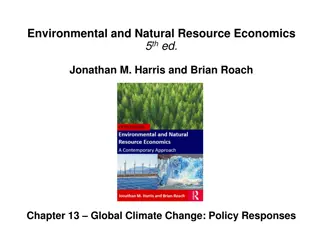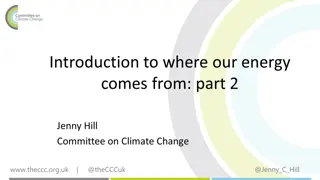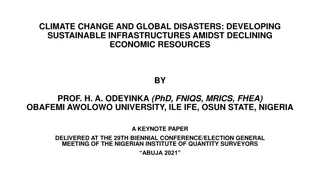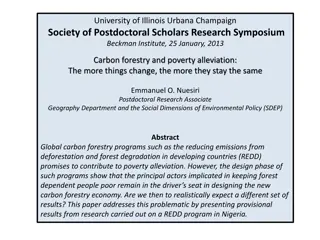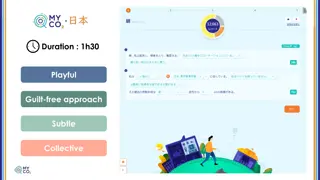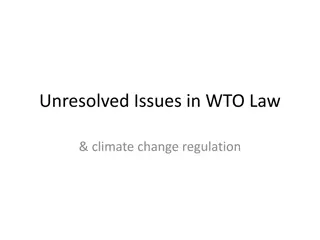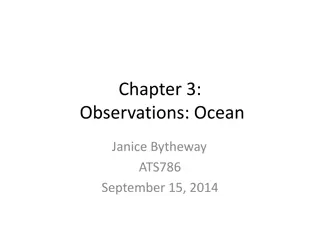Understanding the Carbon Scenario Tool for Climate Change Management
The Carbon Scenario Tool (CST) is a valuable resource developed by the University of Edinburgh and the Scottish Funding Council to manage, report, and forecast carbon emissions for university estates and operations. It enables the calculation of the impact of carbon reduction projects and the development of scenarios based on various factors like student and staff numbers, floor areas, and electricity grid decarbonization. The tool helps in assessing performance, improving reporting, and fulfilling climate change duties for public bodies through carbon footprint analysis and green scoring. The webinar outlines the tool's elements, from carbon footprint assessment to scenario building and project incorporation, emphasizing its significance in climate change strategy and management.
- Carbon Scenario Tool
- Climate Change Management
- Carbon Footprint
- Sustainability Planning
- University Operations
Download Presentation

Please find below an Image/Link to download the presentation.
The content on the website is provided AS IS for your information and personal use only. It may not be sold, licensed, or shared on other websites without obtaining consent from the author. Download presentation by click this link. If you encounter any issues during the download, it is possible that the publisher has removed the file from their server.
E N D
Presentation Transcript
Demonstration of the Carbon Scenario Tool
Webinar outline Time Background to the Carbon Scenario Tool, including history and process of development 13:00 13:05 Overview of the various Carbon Scenario Tool elements 13:05 13:10 Introduction to Carbon Footprinting facility 13:10 13:20 Introduction to forecasting facility and dataset requirements 13:20 13:25 Building a forecast based on future additional building opening and closures 13:25 13:30 Introduction to scenario facility and data requirements 13:30 13:35 Building a scenario based on future student and floor area increases 13:35 13:45 Incorporating carbon reduction projects 13:45 13:50 Interpreting overall results and using graphs and outputs in Climate Change Strategy documents 13:50 14:00
Background to the Carbon Scenario Tool Developed as a joint funded project between University of Edinburgh and the Scottish Funding Council Designed to manage, report and forecast carbon emissions for the University s estate and operations It can calculate the impact of carbon reduction projects on the carbon footprint Enable the development of scenarios that project future carbon footprints based on: Changing student and staff numbers Changing floor areas Decarbonisation of the electricity grid
What is the Carbon Scenario Tool for? Data tools Reporting Performance Improvement Climate Change Assessment Tool Public Bodies Climate Change Duties Report Carbon Footprint and Project Register Tool Public Sector Estates Management Report Green scorecard Carbon Scenario Tool HE specific
Overview of CST elements Carbon Footprint past, current and future Carbon reduction projects Carbon projection module: Student numbers Staff number Floor area Grid electricity factor Business as Usual Forecast: Changes to estate Changes to operations Grid electricity factor Forecast output CSM output
Out of boundary: Emission sources within Carbon Management boundary: Campus A 25% of floor area Campus D 55% of floor area Refrigerants Electricity generation & T&D losses Electricity generation & T&D losses Water Supply & treatment Water Supply & treatment Staff commuting Business travel Taxi Natural gas - direct Natural gas - direct Natural gas - CHP Natural gas - CHP Bus Commercial & industrial waste to landfill Commercial & industrial waste to landfill Private car Private car Rail Air Air Outsourced activities Campus B 10% of floor area Campus C 10% of floor area Procurement of goods/services Electricity generation & T&D losses Electricity generation & T&D losses Water Supply & treatment Water Supply & treatment Key Natural gas - direct Natural gas - direct Scope 1 Scope 2 Commercial & industrial waste to landfill Commercial & industrial waste to landfill Private car Private car Scope 3 Air Air
Where are you going? 40,000 35,000 Carbon footprint (tCO2e) 30,000 25,000 20,000 15,000 10,000 5,000 - Academic year Forecast (BAU) 7.5% Actual Target
What will you be doing? 50,000 45,000 40,000 35,000 30,000 25,000 20,000 15,000 10,000 5,000 - 2014/15 2015/16 2016/17 2017/18 2018/19 2019/20 2020/21 2021/22 2022/23 2023/24 2024/25 Grid Electricity Natural Gas - direct Natural Gas - CHP
Difference between forecasting and projecting Forecast Projection A forecastis an organisation s estimate of future results and is based on assumptions reflecting conditions it expects to exist and the course of actions it expects to take Natural gas: 3,000,000 kWh A projection presents an organisation s expected position given one or more hypothetical assumptions. It is sometimes used to present one or more hypothetical courses of actions for evaluation. It often answers the "what if question What happens if: What is the impact of a new engineering building? 20,000 m2 Mid-range estimate of consumption: Grid elec: 1,000,000 kWh Student numbers increase by 3% per year Floor area increases by 10% per year
Building a forecast There are a number of ways to do this; very similar to RES CF&PR tool: Add or close buildings to close them, you have to have them separately listed Increase or decrease an emission source Change the grid factor % Change (at Year of Change) Future New Build /operation Year of Change Final Year of Full Operation Existing Building /Operation? 2016/17 2017/18 2018/19 0.438 0.427 0.416 2015/16 5% N/a No 2016/17 Really need your estate listed by building but probably the most accurate short term forecasting method Requires assumptions about the grid Only allows one change per emission sources so carbon footprint has to be listed in detail
Building a scenario; data requirements This is done in the CSM Factors tab but requires the tool to be loaded with information in Space and People allocations Data By year By campus Undergraduate numbers Postgraduate numbers Source: Institution records Academic staff numbers Source: HESA Non-academic staff numbers Floor area Income ( million) No required
How does the tool work? End use matrix End use matrix For the three key emission sources (grid electricity, natural gas direct and natural gas CHP), there are assumed to be a set of end uses: Cooling and ventilation Undergraduates Catering Postgraduates Floor area Other Academic staff Hot water Non academic staff Heating Natural gas - direct
How does the tool work? End use assumptions End use assumptions Estimated percentage Sector Fuel Use Campus A Education Grid Electricity Catering 11% 5% Education Grid Electricity Computing 12% 25% Education Grid Electricity Cooling and Ventilation 2% 2% Education Grid Electricity Hot Water 7% 7% Education Grid Electricity Heating 8% 8% Education Grid Electricity Lighting 51% 45% Education Grid Electricity Other 9% 8% The estimated percentage of end use comes from Government data but can be changed for each campus
Scenario 1: Scenario 1: 2% annual growth in staff and student numbers but area increase (grid factor constant) but no floor 60,000 50,000 Carbon footprint (tCO2e) 40,000 30,000 20,000 10,000 - 2014/15 2015/16 2016/17 2017/18 2018/19 2019/20 2020/21 2021/22 2022/23 2023/24 2024/25 Grid Electricity Water - Supply Flights Economy Short Haul - to/from UK Natural Gas - direct Water - Treatment Car - Average - diesel Natural Gas - CHP Refuse Commercial & Industrial to Landfill
Scenario 2: Scenario 2: 2% annual growth in staff and student numbers and area increase (grid factor constant) and floor 60,000 50,000 Carbon footprint (tCO2e) 40,000 30,000 20,000 10,000 - 2014/15 2015/16 2016/17 2017/18 2018/19 2019/20 2020/21 2021/22 2022/23 2023/24 2024/25 Grid Electricity Water - Supply Flights Economy Short Haul - to/from UK Natural Gas - direct Water - Treatment Car - Average - diesel Natural Gas - CHP Refuse Commercial & Industrial to Landfill
Scenario 3: Scenario 3: 2% annual growth in staff and student numbers and area and and annual 3% decrease in grid factor 60,000 and floor 50,000 Carbon footprint (tCO2e) 40,000 30,000 20,000 10,000 - 2014/15 2015/16 2016/17 2017/18 2018/19 2019/20 2020/21 2021/22 2022/23 2023/24 2024/25 Grid Electricity Water - Supply Flights Economy Short Haul - to/from UK Natural Gas - direct Water - Treatment Car - Average - diesel Natural Gas - CHP Refuse Commercial & Industrial to Landfill
Incorporating carbon reduction projects There is the option to produce a with carbon reductions project forecast or scenario Projects need to be entered into the Projects tab with information about applicable campus, amount of anticipated saving and implementation date Forecasts and projections (with and without projects) are produced: As carbon emissions As consumption units As cost
Interpreting and using outputs Use the CST to develop a range of outcomes for different growth strategies and investment Use graphs in Carbon Strategy documents to help indicate the impact of growth on carbon emissions Use CST to have a discussion with finance managers about capital investment in lower carbon buildings How CST could be used Use the CST to identify gaps in your understanding of what is driving your carbon footprint Use the CST to help develop a strategy for future fuel use composition and investment in technologies Use CST to demonstrate to senior management how likely you are to meet future targets












